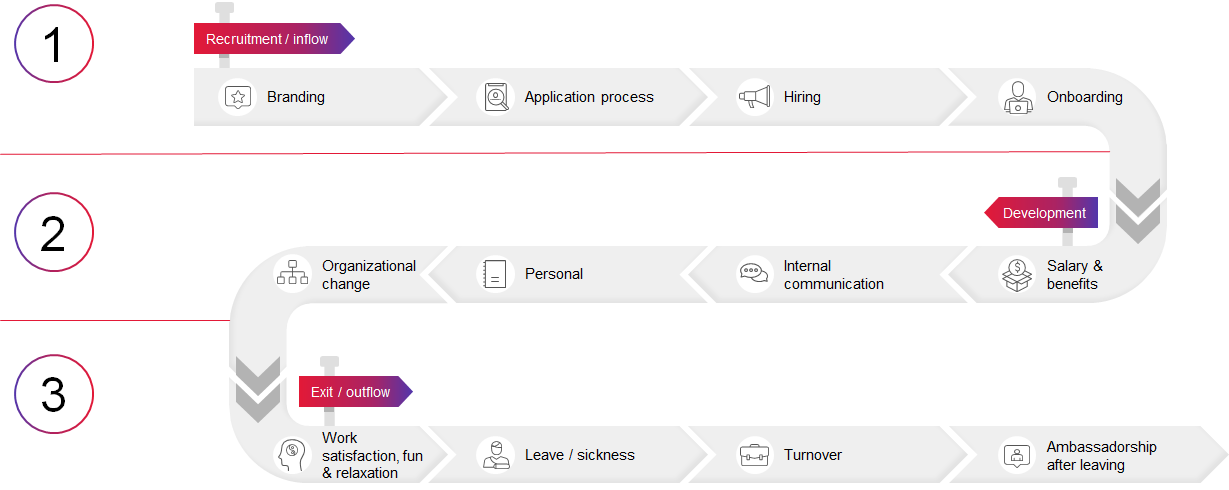Quiet quitting. The Great Resignation. Hybrid working models. The Talent War. What do all these terms have in common? All these terms look at the job market from the employee’s perspective.
Since the start of the pandemic, we’ve seen a few realizations among employees, specifically the ones that were the first to lose their jobs and, quite frankly, have been left out in the cold. Particularly retail and hospitality workers have been hit hard. Meanwhile, as everything has opened back up, demand for those very same jobs has skyrocketed. So what happened to these employees? Because they don’t seem to be coming back. And ask yourself: if you had been unceremoniously dumped, would you go back?
As Richard Branson said: “Clients do not come first. Employees come first. If you take care of your employees, they will take care of the clients. ”Simple? Sure. Easy? Not really. This is underlined by key findings from our annual strategic client interview program where focus on people strategies shows as key to achieving business priorities. For the first time, recruiting and retaining talented employees (“war for talent”) emerges as the top-cited constraint to achieving business priorities. This is closely linked to cultural change and change management, which persists as a barrier. Luckily, companies are starting to pay more and more attention to the way they treat and engage with their employees.
In this blogpost, I’ll help break it down through the use of the employee journey and point out some areas to focus on first.
-
1. Recruitment / inflow
-
In this phase of the journey a potential employee is first brought into contact with your organization, whether you’re directly involved or not. Your branding is of course something that you, at least partly, control. However, there’s a good chance you want to know what the conversation in your industry is among potential hires, or even specifically about your company. One of the ways in which you track the conversation – and if and where needed even contribute to it – is through the combination of social and business analytics. Through accessing publicly available data sources and combining these with your owned data, you can sift out trends or developments. With those insights, you can adjust or realign your communication, hiring practices and show yourself to be committed to listening to your (future) employees.
What are the biggest pain points?
If you look specifically at retail, the employee pain points can be found everywhere. Twitter and Instagram are rife with quotes and memes of the hardships of working retail. If you have platforms that can filter through the sarcasm you can find the underlying and most relevant issues for your company and industry, try to resolve them or just offer some relief. That will set you apart as a brand and draw in more applicants.
The application process varies from organization to organization. That’s not to say that the more tedious parts (yes, tedious) can’t be automated. Think, for example, of processing applicant information into a platform that encrypts and protects personal data, and has the correct processes for consent and deletion built in. The best way to ensure that you’re abiding by the law, is by automating it.
-
2. Development
-
This phase of the journey may be the trickiest stage in which to keep employees engaged and excited. Just like how every new relationship is exciting, as soon as you settle into a routine the novelty tends to wear off. Jobs are no different. Your employee’s goals, aspirations and ambitions are their main priority, and if you can support them in that, you’ll see a dramatic increase in retention rates. The possibilities for career development and growth are not always obvious, particularly in smaller organizations. Still, I would like to challenge you to think outside of the box. For example: you bring high potential store employees into the office to fulfil a role within a test team for new solutions? Can you offer courses or training that will set your employees on a path to more responsibility? How are you taking employees’ feedback into account in your digital roadmaps? Are you looking at process redesign and collaborative innovation?
Some examples and food for thought
One of the most obvious things I can tell you is: be a brand your employees would be proud to be associated with. Are you doing any good for the community? Or for the world? How do you reward your employees? What benefits do you offer?
- An example I can give here around benefits is the following. The law guarantees workers certain rights. Within the Netherlands we have regulations around things like vacation days, parental leave etc. But if you look within the larger European region, you can see we’re actually lagging behind. So what are you as an employer doing that goes above and beyond the minimum legal allowance?
- Another example is the hybrid working model. More and more employers are asking their employees to come back into the office, offering some form of hybrid working. Nobody seems to have found the perfect formula yet, and I’ll let you in on a secret: you won’t. Well, you won’t as long as you don’t allow for any personalization based on your employee wants and needs. And whatever you do, please don’t make up or lie to your employees about the reasoning behind your policies.
If we look at the relevance for the retail market, we can best look at the way the experience on the shop floor is. This can range from how your employees are scheduled (are you considering their needs and requests or sticking to the legal minimum?) to how you push new tech solutions into stores.
Combining insights you can act on
Figuring out which business processes work best for your organization is generally not done within the confines of the C-suite. This is where my team can help you in designing new journeys through a series of deep-dive workshops. We’ll combine our knowledge of the market, retail benchmarks and input about your specific situation to make recommendations on your employee development processes. As a result, you should see a decrease in employee turnover and higher employee loyalty. Because one thing every organization needs to understand: employees don’t owe you their loyalty. Just like with consumers, you have to earn it.
“Employees don’t owe you their loyalty. Just like with consumers, you have to earn it.”
-
3. Exit/outflow
-
All the employee experience management in the world can’t keep your retention rate at 100%. Some employees will move on. Some will retire or switch careers, but some really want to quit working at your company. For this last group, I want you to keep in mind that people don’t quit jobs, they quit bosses. So the way in which they leave your company is very much within your sphere of influence. One of the easiest ways in which to capture key insights is a proper exit procedure and interview. Of course all the feedback in the world won’t help if you can’t quantify and measure these results, and turn them into actions. Turning qualitative data, such as interviews, into measurable improvement points is something that a company like CGI can help you with.
Ambassadorship: how does that work?
But how do you truly accomplish brand ambassadorship by former employees? Be the type of employer, the type of boss somebody would want to work for. Make sure your employees feel valued, appreciated and recognized for their contribution. Reward them accordingly. Mind their workloads. Lead by example.
What’s your next step?
If this blogpost has given you food for thought and you would like to explore what your options as an employer are, feel free to reach out to me to talk. Also, take a look at my other blogs and keep an eye out for my whitepaper around Total Experience, coming soon.






